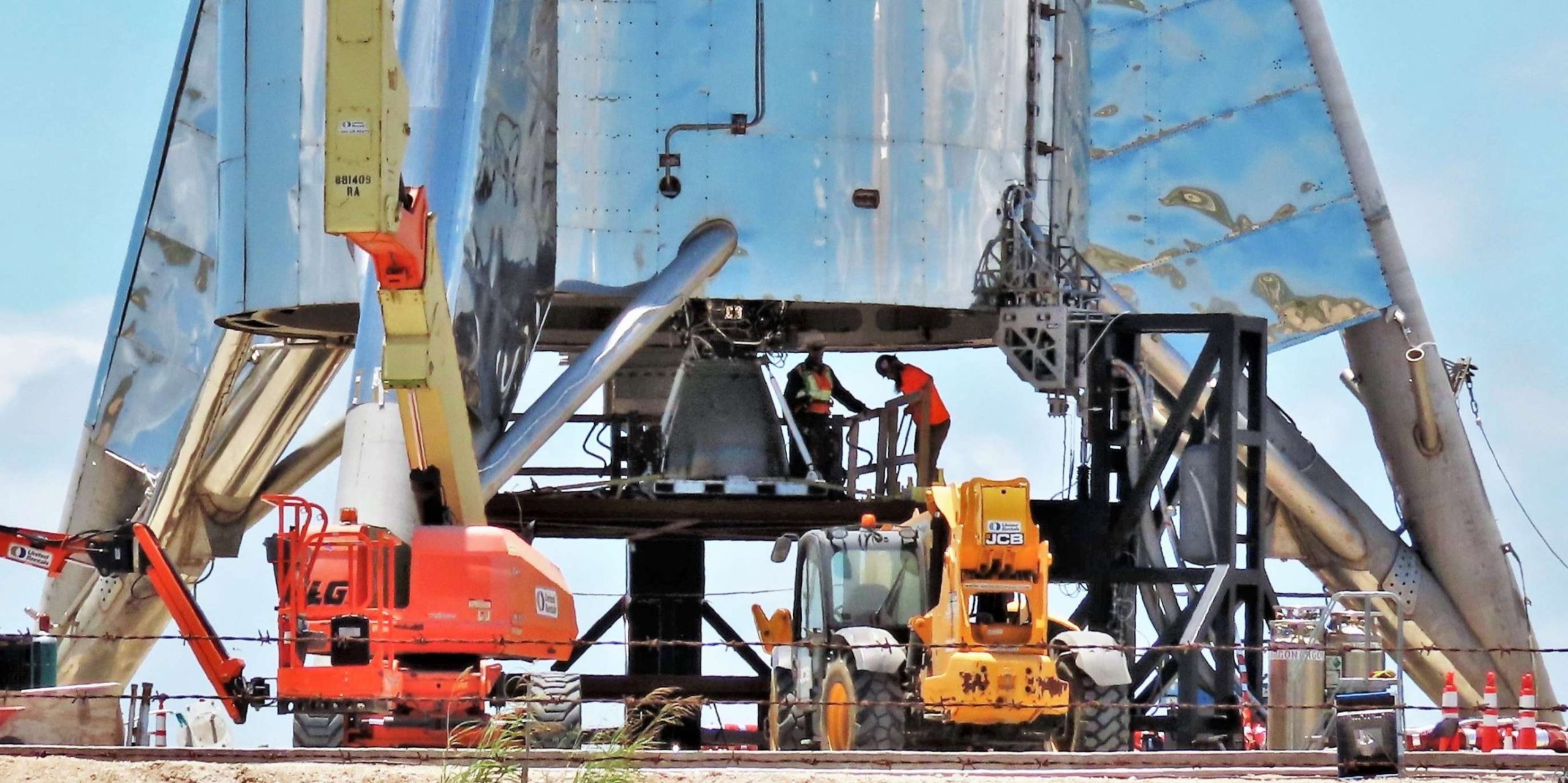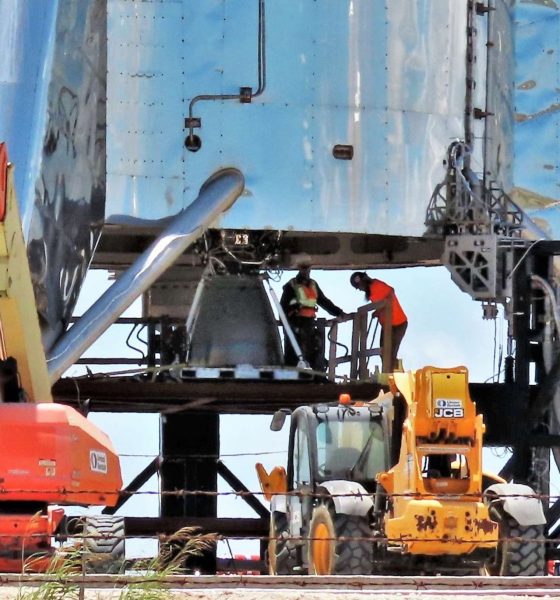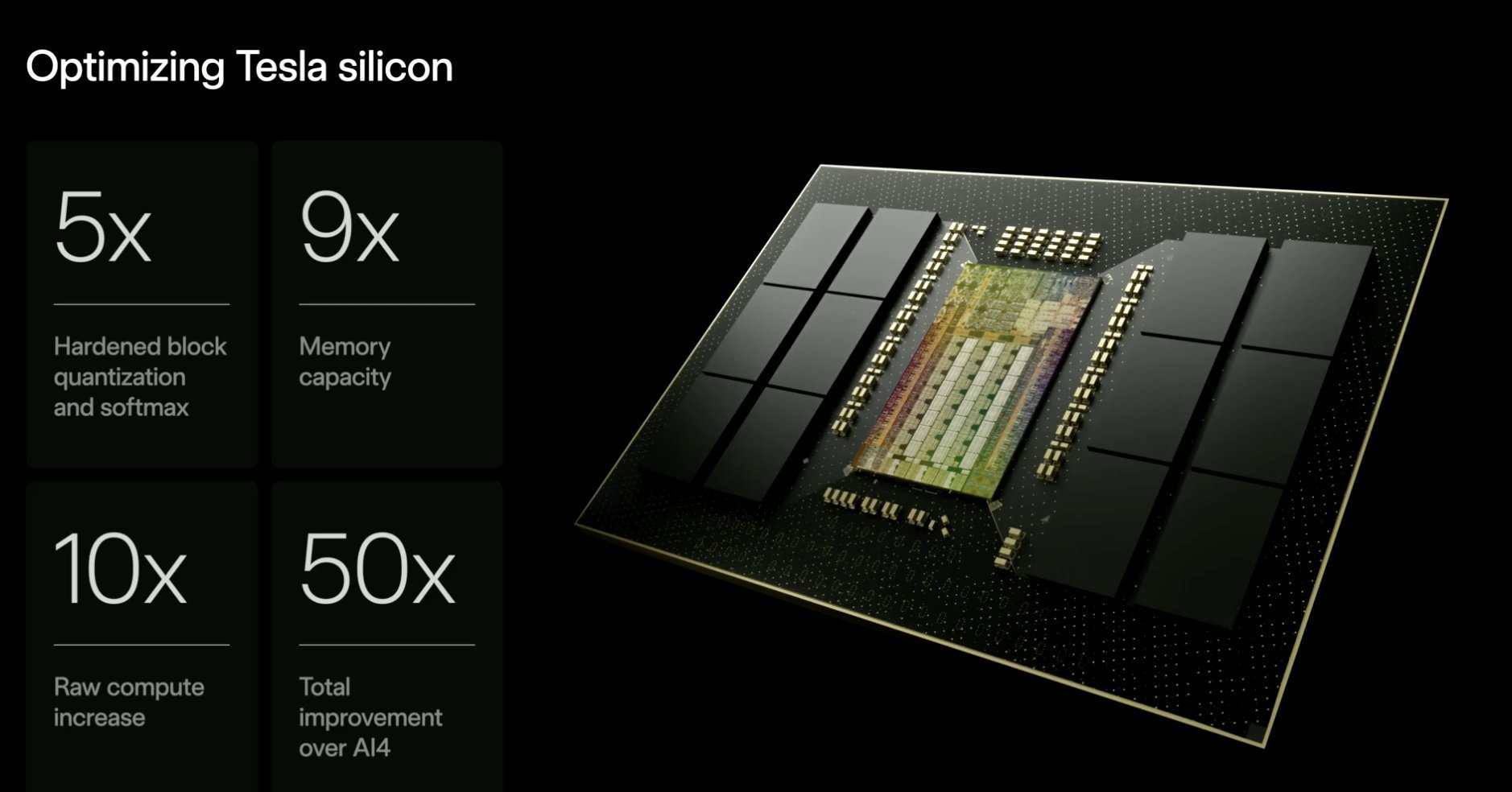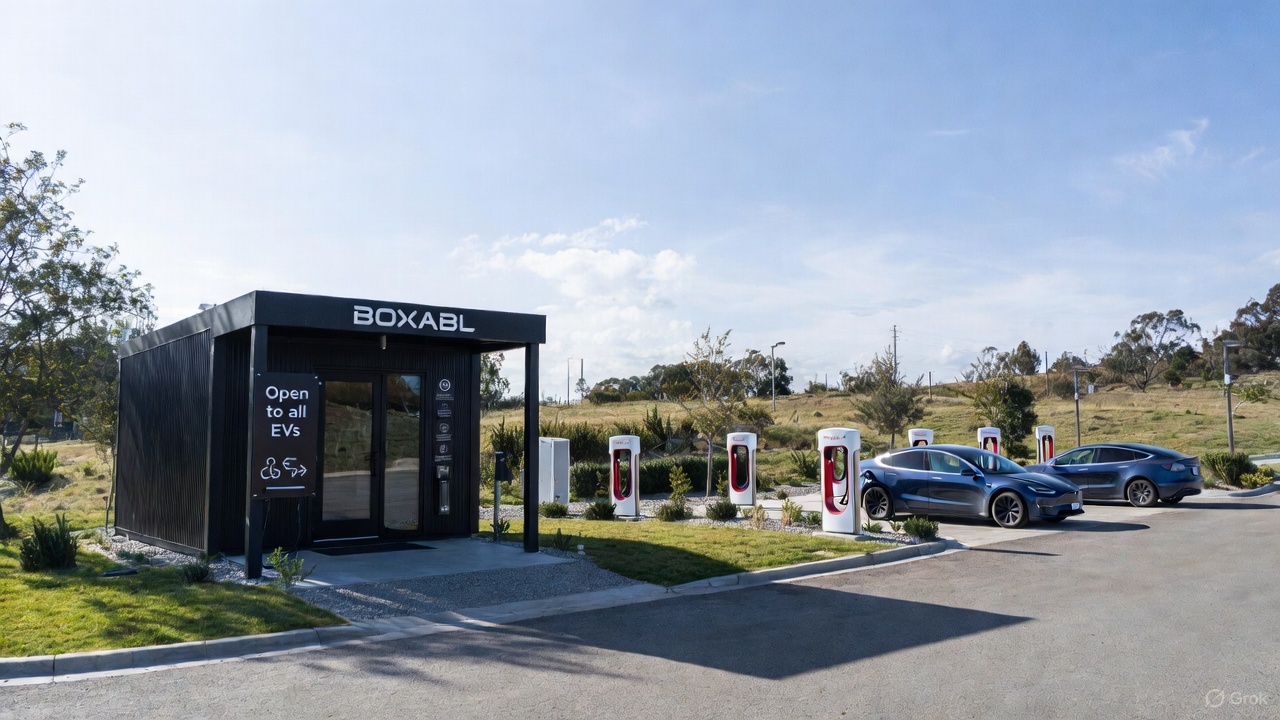

News
SpaceX’s Starhopper readies for more ambitious Raptor-powered flight tests
For the second time in two months, SpaceX technicians have begun to install a Raptor engine on Starhopper, a full-scale Starship testbed theoretically capable of low-velocity, moderate-altitude ‘hops’.
Back in late March, Raptor and Starhopper were joined for the first time, enabling a lengthy series of attempted tests that were followed by two engine ignitions and tethered hops before Raptor was removed for inspection. In the two months since that first round of integrated testing, SpaceX has significantly upgraded Starhopper and its spartan launch facilities, all focused on transforming the odd vehicle from a largely fixed test stand into a giant, mobile Grasshopper.
All the way back in 2012, SpaceX began testing Falcon 9 recovery and reusability concepts with a low-fidelity prototype known as Grasshopper – essentially a minimalist Falcon 9 first stage with ad hoc legs and a single Merlin engine. It supported a series of 8 major test flights – all successful and a source of valuable data – before the vehicle’s 2013 retirement. An upgraded Grasshopper – known instead as Falcon 9 Reusable Development Vehicle (F9R Dev1) – began testing around the same time and continued even higher altitude vertical takeoff/vertical landing (VTVL) tests until its untimely demise in August 2014.
Starhopper is quite similar, although it is also serving as a testbed for a far more varied range of technologies due to the fact that it has been developed before the inaugural launch of its namesake (Starship/Super Heavy). By the time SpaceX started Grasshopper/F9R tests, Falcon 9 had already completed several successful launches. With Starhopper, SpaceX is building and testing its first 9m-diameter ‘flight’ hardware, its first propellant tanks built out of steel, its first flight-capable rocket fueled by methane and oxygen, and its first mobile Raptor testbed, among numerous other things. The challenges are inherently much greater, but SpaceX has the luxury of taking the opposite approach it took towards Falcon 9 and building a launch vehicle entirely around its intended reusability, rather than trying to squeeze a method of reusability around an already-flying rocket.
Saurid Oddities
As noted by NASASpaceflight.com in a June 2nd article, SpaceX seems to be juggling its growing selection of newly-produced and tested Raptor engines in pursuit of Starhopper’s return to flight. According to the publication’s reliable sources,
“Up until recently, [SpaceX] was planning to utilize Raptor SN4 for [Starhopper’s first] untethered hops. However, the company has now decided to utilize this engine only for fit checks, and will instead perform the hops with SN5 – the latest Raptor to come out of SpaceX’s factory in Hawthorne, California.” – NASASpaceflight.com, June 2nd, 2019
This indicates that the Raptor engine delivered to Boca Chica on June 1st and currently in the process of being installed on Starhopper is actually more of a stand-in* for a future Raptor, SN05. The reasons behind this Raptor shuffle elude detection, but it’s possible that the simplest explanation – also posed by NASASpaceflight – is the correct one. By shipping a Raptor that may not be ready for flight tests, SpaceX could likely save anywhere from a few days up to a few weeks by doing everything short of lifting off under the powered of Raptor SN04.
*By all appearances, SN04 is a flight-grade Raptor that has completed assembly and likely been test-fired in McGregor, Texas. Why it may currently be resigned to a “stand-in” role is unknown.
It appears that the Raptor engine is not centered, could it be that they are going straight with the 3 engine test. (Idk honestly, I wonder why this is?) @elonmusk are things about to get epic?? pic.twitter.com/sne5v7SMhy— Austin Barnard? (@austinbarnard45) June 1, 2019
Very curiously, upon Raptor SN04’s South Texas arrival, it appears that SpaceX technicians have indeed rapidly installed the engine on Starhopper, but in a position that is decidedly off-center. Pictured above, the photo could have simply caught the engine while technicians were moving it to its actual installation spot, but it could also indicate that SpaceX is speeding towards Starhopper’s first triple-Raptor test flights.
Starhopper delays?
In line with the last-second switch from Raptor SN04 to Raptor SN05 as the engine-to-be for untethered hops, SpaceX has pushed the start of that test series from approximately May 31st to June 11th. More likely than not, the ~11-day delay is meant to allow time for Raptor SN05’s McGregor, Texas acceptance testing, given that – per CEO Elon Musk – the engine wasn’t even finished as of May 22nd.
On the other hand, with Raptor SN05 now scheduled to support Starhopper hop tests as early as mid-June, it begs the question of whether SpaceX is instead working towards expedited triple-Raptor testing. For unknown reasons, neither Raptor SN03 or SN04 are apparently ready to support flight operations, although both have been thoroughly hot-fired in McGregor. Perhaps each engine is a distinct prototype with a different level of experimental readiness, or perhaps SpaceX is just testing certain engines (like SN03) more extensively than others (SN05).
Regardless, SpaceX now seems to have 3-4 intact, functional Raptor engines (excluding SN01; destroyed during stress testing), 2-3 of which are actively testing or being worked on a day’s drive north of Boca Chica. SN02 – having successfully supported a brief duo of ignition tests with Starhopper – could still be intact and test-ready. SN03 is an unknown quantity, but SN04 is clearly in excellent shape and is probably close to flight-readiness if it isn’t already. This is to say that SpaceX likely already has three Raptors on hand that are capable of supporting multi-engine Starhopper testing, whether or not such a test regime would actually be valuable.
Musk has noted that both orbit-capable Starship prototypes will be far closer to finished products and will thus fly with “at least 3 engines” (3 sea level engines, as it would turn out) or even “all 6” (3 sea level, 3 vacuum-optimized). In the meantime, Starhopper stands with an off-centered Raptor, awaiting the arrival of a different Raptor to kick off a second hop test program. If nothing else, SpaceX’s Starship/Super Heavy development program is operating in a spectacularly hardware-rich fashion, lending itself to the breakneck-pace of iteration and improvement SpaceX is famous for.
Check out Teslarati’s Marketplace! We offer Tesla accessories, including for the Tesla Cybertruck and Tesla Model 3.

News
Tesla supplier Samsung preps for AI5 production with latest move
According to a new report from Sedaily, Samsung is accelerating its preparation for U.S. production of the AI5 chips by hiring veteran engineers for its Customer Engineering team.

Tesla supplier Samsung is preparing to manufacture the AI5 chip, which will launch the company’s self-driving efforts even further, with its latest move.
According to a new report from Sedaily, Samsung is accelerating its preparation for U.S. production of the AI5 chips by hiring veteran engineers for its Customer Engineering team, which will help resolve complex foundry challenges, stabilize production and yields, and ensure manufacturing goes smoothly for the new project.
The hiring push signals that Tesla’s AI5 project is moving forward quickly at Samsung, which was one of two suppliers to win a contract order from the world’s leading EV maker.
🚨🚨 FIRST LOOK at Tesla’s AI5 chip, which will be available in late 2026 or early 2027 pic.twitter.com/aLomUuifhT
— TESLARATI (@Teslarati) November 6, 2025
TSMC is the other. TSMC is using its 3nm process, reportedly, while Samsung will do a 2nm as a litmus test for the process.
The different versions are due to the fact that “they translate designs to physical form differently,” CEO Elon Musk said recently. The goal is for the two to operate identically, obviously, which is a challenge.
Some might remember Apple’s A9 “Chipgate” saga, which found that the chips differed in performance because of different manufacturers.
The AI5 chip is Tesla’s next-generation hardware chip for its self-driving program, but it will also contribute to the Optimus program and other AI-driven features in both vehicles and other projects. Currently, Tesla utilizes AI4, formerly known as HW4 or Hardware 4, in its vehicles.
Tesla teases new AI5 chip that will revolutionize self-driving
AI5 is specialized for use by Tesla as it will work in conjunction with the company’s Neural Networks, focusing on real-time inference to make safe and logical decisions during operation.
Musk said it was an “amazing design” and an “immense jump” from Tesla’s current AI4 chip. It will be roughly 40 times faster, and have 8 times the raw compute, with 9 times the memory capacity. It is also expected to be three times as efficient per watt as AI4.
“We’re going to focus TSMC and Samsung, initially, on AI5. The AI5 chip, design by Tesla, it’s an amazing design. I’ve spent almost every weekend for the last few months with the chip team working on AI5.”
It will be 40x better than the AI4 chip, Musk says.
— TESLARATI (@Teslarati) October 22, 2025
AI5 will make its way into “maybe a small number of units” next year, Musk confirmed. However, it will not make its way to high-volume production until 2027. AI5 is not the last step, either, as Musk has already confirmed AI6 would likely enter production in mid-2028.
News
Tesla discloses interesting collaboration partner for Supercharging
This BOXABL collaboration would be a great way to add a rest stop to a rural Supercharging location, and could lead to more of these chargers across the U.S.

Tesla disclosed an interesting collaboration partner in an SEC filing, which looks like an indication of a potential project at Supercharger sites.
Tesla said on Tuesday in the filing that it was entering an agreement with BOXABL to design and build a Micromenity structure. Simply put, this is a modular building, usually a few hundred square feet in size, and it has been seen at Superchargers in Europe.
In Magnant, France, Tesla opened a small building at a Supercharger that is available to all EV owners. There are snacks and drinks inside, including ice cream, coffee, a gaming console, and restrooms. It gives people an opportunity to get up and out of their cars while charging.
This building was not built by BOXABL, but instead by bk World Lounges. It is likely the final Supercharging stop before people get to Paris, as it is located 250 kilometers, or 155 miles, from the City of Light.
Voir cette publication sur Instagram
Magnant has 56 stalls, so it is a large Supercharging stop compared to most. The building could be a sign of things to come, especially as Tesla has opened up larger Supercharger stations along major roadways.
It is for just a single building, as the Scope of Work within the filing states “a comprehensive package for one Micromenity building.”
NEWS: BOXABL, a company that creates modular, prefabricated buildings, has entered into an agreement with @Tesla.
This is Tesla formally contracting BOXABL to design, engineer, and build a pilot “Micromenity” structure, a compact, modular building unit.
While some info in the… pic.twitter.com/RabJczGpEp
— Sawyer Merritt (@SawyerMerritt) December 9, 2025
Superchargers are commonly located at gas stations, shopping centers, and other major points of interest. However, there are some stops that are isolated from retail or entertainment.
This BOXABL collaboration would be a great way to add a rest stop to a rural Supercharging location, and could lead to more of these chargers across the U.S.
Tesla has done a lot of really great things for Supercharging this year.
Along with widespread expansion, the company launched the “Charging Passport” this week, opened the largest Supercharger in the world in Lost Hills, California, with 168 chargers, opened the Tesla Diner, a drive-in movie restaurant in Los Angeles, and initiated access to the infrastructure to even more automakers.
Elon Musk
Tesla CEO Elon Musk confirms Robotaxi safety monitor removal in Austin: here’s when
Musk has made the claim about removing Safety Monitors from Tesla Robotaxi vehicles in Austin three times this year, once in September, once in October, and once in November.

Tesla CEO Elon Musk confirmed on Tuesday at the xAI Hackathon that the company would be removing Safety Monitors from Robotaxis in Austin in just three weeks.
This would meet Musk’s timeline from earlier this year, as he has said on several occasions that Tesla Robotaxis would have no supervision in Austin by the end of 2025.
On Tuesday, Musk said:
“Unsupervised is pretty much solved at this point. So there will be Tesla Robotaxis operating in Austin with no one in them. Not even anyone in the passenger seat in about three weeks.”
Musk has made the claim about removing Safety Monitors from Tesla Robotaxi vehicles in Austin three times this year, once in September, once in October, and once in November.
In September, he said:
“Should be no safety driver by end of year.”
The safety driver is just there for the first few months to be extra safe.
Should be no safety driver by end of year.
— Elon Musk (@elonmusk) September 4, 2025
On the Q3 Earnings Call in October, he said:
“We are expecting ot have no safety drivers in at least large parts of Austin by the end of this year.”
Finally, in November, he reiterated the timeline in a public statement at the Shareholder Meeting:
“I expect Robotaxis to operate without safety drivers in large parts of Austin this year.”
Currently, Tesla uses Safety Monitors in Austin in the passenger’s seat on local roads. They will sit in the driver’s seat for highway routes. In the Bay Area ride-hailing operation, there is always a Safety Monitor in the driver’s seat.
Three weeks would deliver on the end-of-year promise, cutting it close, beating it by just two days. However, it would be a tremendous leap forward in the Robotaxi program, and would shut the mouths of many skeptics who state the current iteration is no different than having an Uber.
Tesla has also expanded its Robotaxi fleet this year, but the company has not given exact figures. Once it expands its fleet, even more progress will be made in Tesla’s self-driving efforts.








